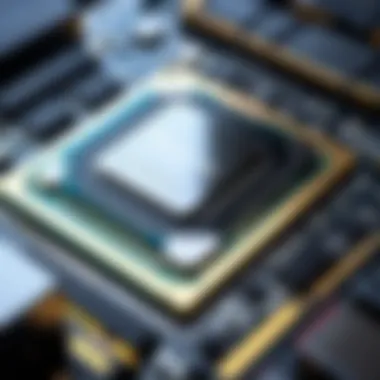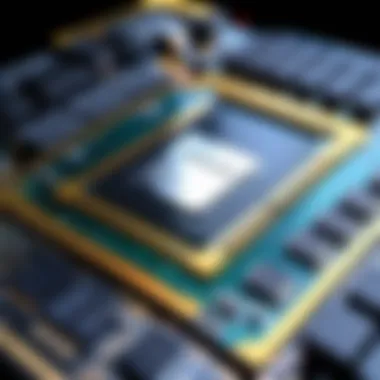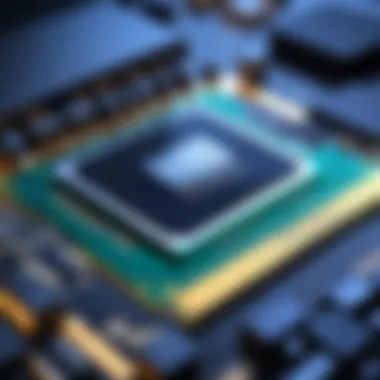Understanding 8 GB DDR4 RAM: Specs and Performance


Intro
In today’s digital age, memory plays a critical role in the performance of computing systems. As technology advances, new types of Random Access Memory (RAM) are developed to meet increasing demands. Among these, 8 GB DDR4 RAM stands out as a versatile option for a wide range of applications. This memory type not only offers improved speed and efficiency but also enhances the overall user experience, particularly in gaming and content creation.
Understanding the specifications and benefits of 8 GB DDR4 RAM is essential for anyone looking to upgrade or build a computer system. With its capacity, generation, and performance implications, this guide will delve into every aspect of 8 GB DDR4 memory, clarifying its impact on varying computing needs. The article will cover technical specifications, practical performance insights, and considerations for both consumers and professionals who seek the best out of their setups.
Foreword to RAM and Its Functionality
In the realm of computing, RAM plays a crucial role. Understanding its functionality is key to grasping how systems operate efficiently. This article dives into various aspects of 8 GB DDR4 RAM, especially focusing on its specifications and benefits.
Overview of Random Access Memory
Random Access Memory, or RAM, serves as the memory that a computer uses to store data temporarily for quick access. When programs are executed, they rely on RAM to hold the instructions and data needed for processing. The term "random access" signifies that any byte of memory can be accessed without touching the preceding bytes. This contrasts with types of storage like hard drives, where data access times can vary greatly.
RAM is volatile memory, which means it loses all stored information when power is switched off. This characteristic emphasizes the need for constant power when using RAM, ensuring that tasks happen quickly during operation. Higher capacities and faster technologies in RAM types improve overall system responsiveness, an important factor in modern computing.
The Importance of RAM in Computing
RAM is a foundational component in computing performance. Without sufficient RAM, a computer can slow down significantly when multitasking or running demanding applications. The amount of RAM directly influences how many applications can run smoothly at the same time.
- Enhancing Speed: When a computer has enough RAM, it can operate efficiently, reducing the need for swapping data in and out of slower storage options.
- Impact on User Experience: Systems equipped with adequate RAM provide better experiences in gaming, content creation, and general multitasking. Such efficiency leads to fewer interruptions and smoother transitions.
- System Lifespan: Investing in quality RAM can prolong the life of a system. It allows users to run newer software and applications without the need for immediate upgrades.
In summary, understanding RAM and its functionalities sets the groundwork for deeper insights into 8 GB DDR4 RAM's importance in today's technology landscape.
What is DDR4 RAM?
Understanding DDR4 RAM is crucial as it plays a fundamental role in modern computing systems. This section aims to clarify what DDR4 RAM is, why it matters, and how it has evolved from its predecessors. Knowing the details behind this technology will help users make informed choices about memory requirements.
Defining DDR4 Technology
DDR4, or Double Data Rate 4, is a type of synchronous dynamic random-access memory (SDRAM). It is designed to improve upon previous generations, specifically DDR3. The main characteristic of DDR4 is its ability to transmit data on both the rising and falling edges of the clock cycle, effectively doubling the data transfer rate.
One key specification of DDR4 RAM is its increased density. This means that more memory capacity can fit into the same physical space. DDR4 modules can easily have capacities of 8 GB or more per stick, allowing users to maximize their system's RAM without needing extensive hardware upgrades.
Additionally, DDR4 RAM operates at lower voltages, typically around 1.2 volts, compared to DDR3's 1.5 volts, thus improving energy efficiency. This lower power consumption is particularly important for mobile devices and laptops, where battery life is a primary concern.
Key Differences Between DDR3 and DDR4
The transition from DDR3 to DDR4 comes with several essential differences:
- Data Transfer Rates: DDR4 offers higher data transfer rates starting from 1600 MT/s and going up to 3200 MT/s or beyond, compared to DDR3's 800 MT/s to 2133 MT/s. This increase allows for faster data processing capabilities in applications and games.
- Latency: DDR4 introduces additional latency in terms of operations per second compared to DDR3. However, the benefits in bandwidth and overall performance outweigh this minor drawback in most real-world applications.
- Memory Density: DDR4 RAM has a higher maximum capacity per module, allowing configurations of 16 GB and 32 GB in a single stick, which can be beneficial for tasks requiring high memory loads, such as video editing and 3D rendering.
- Energy Efficiency: As mentioned earlier, DDR4 operates at a lower voltage, leading to reduced overall power consumption. This change is particularly beneficial in large server farms and energy-sensitive devices.
Specifications of GB DDR4 RAM
The specifications of 8 GB DDR4 RAM are essential in understanding its capabilities and performance. These specifications define how well the RAM can perform in various tasks, influencing everything from gaming to professional applications. In this section, we will delve into several key specifications, including data transfer rates, latency, and physical characteristics, to provide a clear picture of what 8 GB DDR4 RAM can offer.
Data Transfer Rates and Bandwidth


Data transfer rates are crucial for the overall performance of RAM. The 8 GB DDR4 RAM typically operates at transfer rates between 2133 MT/s to 3200 MT/s. These rates indicate how fast the RAM can exchange data with the processor. Higher transfer rates often result in better system responsiveness and an improved experience in memory-intensive tasks.
Bandwidth is another important aspect. DDR4 RAM offers greater bandwidth compared to its predecessor, DDR3. For instance, the bandwidth of DDR4 RAM at 2400 MT/s can reach up to 19.2 GB/s. This increase in bandwidth means that applications, especially those that require significant memory usage, can access data more efficiently.
Higher data rates and bandwidth translate to smoother operation in applications requiring quick access to memory, such as gaming and video editing software.
Latency and Performance Metrics
Latency is often overlooked, yet it significantly affects performance. The CAS latency (Column Address Strobe latency) for 8 GB DDR4 RAM usually ranges from CL15 to CL22. A lower CAS latency means quicker response times. Although higher speeds can compensate for higher latency in some situations, it's important to strike a balance for optimal performance.
Performance metrics also include how RAM behaves under load. 8 GB DDR4 RAM can handle multitasking effectively. Users will notice less lag when running multiple applications simultaneously. Additionally, benchmarks for DDR4 RAM illustrate its efficiency during intensive workloads, confirming its superior performance compared to older standards.
"When it comes to gaming and professional applications, the combination of speed and low latency in DDR4 RAM can be a game changer."
Physical Characteristics
The physical characteristics of 8 GB DDR4 RAM should not be underestimated. These RAM modules are smaller than previous versions, which contributes to energy efficiency and heat management. Standard DDR4 dimensions typically vary between 288 pins for DIMM modules and 260 pins for SODIMM configurations used in laptops.
Moreover, DDR4 RAM often features better cooling solutions. Many manufacturers equip their modules with heat spreaders to dissipate heat effectively during heavy use. This not only prolongs the lifespan of the RAM but also ensures consistent performance by preventing thermal throttling.
Understanding these specifications enables users to make informed decisions based on their specific computing needs. Whether for gaming, content creation, or general use, recognizing the significance of these elements in 8 GB DDR4 RAM plays a vital role in optimizing overall system performance.
Advantages of GB DDR4 RAM
The advantages of 8 GB DDR4 RAM are crucial in today’s computing environment. As more demanding applications and operating systems evolve, the need for efficient memory solutions becomes ever more critical. This section will explore the specific benefits of 8 GB DDR4 RAM, including enhanced multitasking capabilities, increased energy efficiency, and compatibility with modern processes.
Enhanced Multitasking Capabilities
One of the primary advantages of 8 GB DDR4 RAM is its significant enhancement of multitasking capabilities. In a world where users frequently run multiple applications simultaneously, the role of RAM becomes vital. With 8 GB of DDR4, users can effectively switch between tasks without noticeable lag. This increased memory capacity allows for smoother performance when running intensive software, such as video editing tools or high-resolution graphic design programs.
- When using 8 GB DDR4 RAM, the system can store more data temporarily, making it quick to access necessary files and applications. This means that users can take on complex projects or engage in heavy research without fearing system slowdowns.
- The benefit extends to gaming as well. Modern games require substantial resources, and 8 GB DDR4 RAM ensures that both the game and background processes can run efficiently.
Increased Energy Efficiency
Another important benefit of 8 GB DDR4 RAM is its increased energy efficiency. DDR4 technology incorporates various design improvements that allow it to operate at lower voltages than earlier RAM types. This feature not only helps in reducing power consumption but also contributes to heat management within the system.
- Lower energy consumption translates to improved battery life in laptops and mobile devices. Users can enjoy extended usage without needing a power source.
- Additionally, energy-efficient RAM can contribute to a more sustainable computing environment. Systems using 8 GB DDR4 RAM produce less heat and stress on cooling components, potentially increasing the lifespan of the overall hardware.
Compatibility with Modern Processes
The compatibility of 8 GB DDR4 RAM with modern computing processes cannot be overstated. Most new motherboards support DDR4 technology, making integration into new builds or upgrades straightforward.
- DDR4 RAM is designed to work alongside modern processors, facilitating optimal performance in multi-core settings. This harmony between RAM and CPU ensures that the system can leverage its full potential without bottlenecks.
- Moreover, 8 GB DDR4 RAM meets the requirements of popular operating systems and software. By choosing this memory type, users ensure their systems remain relevant and capable of handling current and future applications effectively.
In summary, 8 GB DDR4 RAM offers significant advantages by enhancing multitasking capabilities, promoting energy efficiency, and ensuring compatibility with modern processes. These factors make it a valuable choice for both casual users and tech enthusiasts.
These elements combined not only elevate user experiences but also provide a foundation for future upgrades.
Performance Implications of GB DDR4 RAM


The performance implications of 8 GB DDR4 RAM extend beyond mere specifications. It plays a critical role across various computing environments, including gaming, content creation, and everyday tasks. The right amount of RAM affects the smoothness of operations, loading times, and overall efficiency of applications. Thus, understanding its impact is essential for both enthusiasts and casual users alike.
Impact on Gaming Performance
For gamers, having sufficient RAM is crucial. With 8 GB DDR4 RAM, players can experience improved performance in resource-intensive games. Many modern titles require substantial memory to load textures, shaders, and other assets efficiently. Without enough RAM, players often face lag and long load times, which can diminish the overall gaming experience.
Most current games tend to recommend a minimum of 8 GB for optimal performance. This amount helps ensure that the system runs smoothly, especially when multitasking, such as streaming or using voice chat software alongside a game. Having adequate RAM minimizes stuttering during crucial moments of gameplay, contributing to a more immersive experience.
Performance in Content Creation Software
Content creators benefit significantly from 8 GB DDR4 RAM. Applications like Adobe Premiere Pro, Photoshop, and AutoCAD demand considerable memory resources. When working on projects that involve high-resolution images or complex video edits, 8 GB provides a substantial buffer. This memory capacity aids in rendering effects and real-time playback, which are essential for a seamless workflow.
Moreover, multitasking is quite common in content creation. Many creators run multiple applications at once, such as a video editing software, a web browser with numerous tabs, and perhaps even music editing software. In this context, having 8 GB DDR4 RAM ensures that system performance remains stable. This leads to increased productivity and a reduction in frustration when working on demanding projects.
Everyday Computing Efficiency
For everyday tasks, 8 GB DDR4 RAM facilitates a user-friendly computing experience. Tasks such as browsing the web, streaming videos, and using office applications become more efficient with this amount of RAM. Frequent tasks performed by average users include maintaining numerous browser tabs open, running background applications, and engaging in multimedia consumption.
With 8 GB, users experience less lag and faster response times. Applications launch more swiftly, and switching between them is smooth. In addition, users are less likely to encounter the disruptions that occur when systems run out of memory. This reliability makes 8 GB an attractive choice for individuals who do not require extreme performance but still desire a dependable and responsive system.
"The significance of RAM in performance cannot be overstated; it is like the breathing space your computer needs to operate effectively across different applications."
In summary, the performance implications of 8 GB DDR4 RAM are substantial. Whether for immersive gaming, efficient content creation, or daily computing tasks, this amount of RAM provides notable advantages that cater to a wide range of users. Choosing RAM wisely ensures that all computing needs are met, enhancing the overall user experience.
Comparative Analysis: GB DDR4 vs. Other RAM Types
The comparative analysis of 8 GB DDR4 RAM against other types of RAM is crucial. It helps in understanding the advantages and limitations of DDR4 in relation to alternatives like DDR3 and DDR5. This analysis not only provides insights for users looking to upgrade or build systems but also highlights trends in memory technology.
Comparing DDR4 with DDR5
DDR5 is the latest generation of memory that aims to improve upon DDR4 specifications. While both serve similar purposes in enhancing computer performance, DDR5 brings significant advancements.
- Data Rate and Bandwidth: DDR5 promises higher data rates, starting around 4800 MT/s and stretching beyond 8400 MT/s. In contrast, DDR4 typically ranges from 2133 MT/s to around 3200 MT/s. This increase in speed offers better performance for data-intensive applications, benefiting users who demand efficiency.
- Capacity: DDR5 supports larger module sizes, allowing for greater memory capacities on a single stick, up to 64 GB. This may not seem significant for casual users but is highly useful for data centers and intensive computing environments.
- Power Efficiency: DDR5 uses lower voltage operation, about 1.1V compared to DDR4’s 1.2V, reducing power consumption. This slight reduction can lead to better energy savings over time, especially in larger setups.
However, DDR4 remains relevant, particularly in budget-oriented builds or for users whose applications do not require cutting-edge memory technology.
Value Proposition Against DDR3
When comparing 8 GB DDR4 RAM to DDR3, several aspects make DDR4 an attractive option for users.
- Performance Improvements: DDR4 provides improvements in both speed and bandwidth. DDR3 typically tops at 2133 MT/s while DDR4 starts at 2133 MT/s and quickly climbs higher. Higher speeds mean reduced lag in applications, benefiting tasks ranging from gaming to professional content creation.
- Future-Proofing: As software and hardware evolve, the demand for memory performance increases. Opting for DDR4 instead of DDR3 ensures compatibility with future systems and applications designed to leverage modern RAM standards.
- Long-term Cost Efficiency: While DDR4 modules may have a higher upfront cost compared to outdated DDR3, the enhanced performance may lead to better overall system longevity. Investing in DDR4 can save money in the long run by delaying future upgrades.
In essence, the choice between DDR4 and its predecessors lies not only in prices but in the performance capabilities that can shape user experiences.
The comparative analysis thus highlights the significance of DDR4 in today's computing landscape while demonstrating the benefits of newer RAM technologies.
Choosing the Right RAM for Your Needs


When it comes to selecting RAM, the choices can feel overwhelming. Choosing the right RAM is a crucial step in optimizing your computer’s performance. It influences how your device handles applications, gaming, and multitasking situations. Knowing what you need can help avoid potential frustrations in the future.
Assessing Your Computing Requirements
Understanding your specific computing requirements is key. Different tasks demand different levels of RAM performance. Gamers, for instance, might need higher bandwidth to ensure seamless gameplay. On the other hand, someone who primarily browses the internet or uses basic office applications may find 8 GB sufficient.
You should also consider the types of software you run. Applications that deal with large files, such as video editing tools and CAD programs, often require substantial memory. Evaluating the specifications of these applications can clarify how much RAM you need to support optimal performance. For gaming enthusiasts, checking the recommended RAM for popular games can provide insight into necessary specifications.
Budget Considerations
Budget is another vital aspect when choosing RAM. 8 GB DDR4 RAM is typically priced competitively, but costs can vary significantly based on brand and speed. It is essential to balance quality and pricing to ensure you are making a wise financial decision.
Prices tend to fluctuate based on market trends, so researching current memory prices is advisable. There may also be sales or discounts, especially during certain times of the year, which could offer a chance to buy more RAM at a lower cost. Consider whether additional investment in higher-performance RAM can provide more value in the long term, particularly if you plan to upgrade your system later.
Long-Term Viability of Your RAM Purchase
Considering the long-term viability of the RAM you purchase can save you money and effort in the future. RAM technology evolves rapidly, and what seems adequate today might become outdated quickly. Therefore, when buying 8 GB DDR4 RAM, assess how well it might serve you in the years ahead.
Investing in RAM that offers upgradability can be a strategic choice. Ensure that your motherboard supports higher RAM capacities as technology advances. A forward-thinking approach will allow you to expand your setup instead of replacing all components later.
"The right RAM can significantly enhance your user experience, steering you clear of limitations imposed by insufficient memory."
Ultimately, making informed decisions based on these considerations can lead to better performance and satisfaction with your computing experience.
Future Trends in Memory Technology
Future trends in memory technology are crucial in understanding how computing performance continues to evolve. As we witness rapid advancements in technology, the role of memory becomes even more pivotal. 8 GB DDR4 RAM has proven its worth, but what comes next is just as essential. Examining forthcoming developments helps consumers make educated choices, shaping their computing experiences.
Forecasting Developments in DDR Standards
The evolution of DDR standards directly influences the performance of RAM. DDR5 is emerging as the successor to DDR4, boasting significant improvements in speed and efficiency. Expected data rates for DDR5 start at 4800 MT/s, which is higher compared to the initial rates of DDR4. Furthermore, the increased memory bandwidth enhances overall system performance. Users can expect faster load times, smoother multitasking, and better compatibility with high-performance applications like gaming and virtual reality.
Considerations for transition also arise. Consumers need to verify whether their motherboards and CPUs support DDR5 before investing. As more manufacturers adopt this technology, transitioning may become necessary to stay up to date with performance standards.
Emerging Technologies and Their Implications
Technological innovations beyond traditional DDR standards are also influencing future memory paradigms. Technologies like 3D NAND flash, Persistent Memory, and HBM (High Bandwidth Memory) alter the landscape of memory architecture. 3D NAND brings better storage efficiency, allowing for larger capacities without expanding physical size. Persistent memory provides faster access to data while maintaining it even after power loss.
In gaming, faster memory technologies translate to improved loading times. Creative professionals benefit as high-speed storage leads to enhanced capabilities in editing and rendering. The demand for memory solutions across various sectors continues to rise, pushing manufacturers to innovate.
"As RAM technology progresses, the distinction between storage and memory blurs, enhancing performance on all fronts."
Advancements in memory technology affect both design and functionality. Understanding these trends is crucial for consumers who seek to optimize their computing power. Choices made today can significantly impact future performance. With continued advancements, memory technologies will influence the efficiency of both personal and professional computing environments.
End
In this article, the conclusion serves a vital role in synthesizing the information presented throughout. It reiterates key insights about 8 GB DDR4 RAM and underlines its importance in today’s computing world. By understanding its specifications, advantages, and impact on performance, readers can make better-informed decisions related to their computing needs. This understanding is not just relevant for tech enthusiasts but also for casual consumers and gamers.
Recap of the Significance of GB DDR4 RAM
The significance of 8 GB DDR4 RAM lies in its balanced performance and compatibility. As technology advances, having adequate memory is crucial. 8 GB serves as an efficient choice for various tasks, including gaming, content creation, and regular computing tasks. Furthermore, the energy efficiency and improved multitasking capabilities of DDR4 technology position it favorably against its predecessors. Users benefit from smoother experiences and enhanced system responsiveness, which are critical for demanding applications.
Final Thoughts on Making an Informed Choice
When choosing RAM, individuals should consider their specific requirements and budget. 8 GB DDR4 RAM stands as a versatile option for many. Still, evaluating whether it meets your needs is essential. It is also important to consider future-proofing as technology evolves. Informed choices contribute to optimized performance and satisfaction with your computing experience. Ultimately, understanding the nuances of 8 GB DDR4 RAM can lead to more successful investments in technology.



